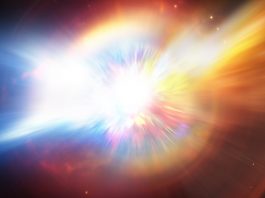Astronomers from the Chalmers University of Technology in Sweden have utilised the Alma telescope to discover the phenomenon of two stars embracing as they come into close proximity.
Unlike our Sun, most stars live with a companion. Sometimes, two stars gather in such a close proximity that one engulfs the other, with comprehensive consequences.
A team of astronomers led by Chalmers University of Technology, utilised the giant telescope ‘Alma’ to study 15 unusual stars in our galaxy over 5000 light years from Earth, and discovered that they all recently underwent this phase of embracing. This discovery promises a new insight into the sky’s most dramatic phenomena, and reveals more about the life, death and rebirth of stars.
The astronomers’ measurements highlight that all the stars are situated in pairs, and that all have recently experienced a rare phase that is not widely understood but is believed to lead to many other astronomical phenomena.
Located 5000m above sea level in Chile, the Alma telescope is sensitive to light with wavelengths of around one millimetre. This is invisible to the human eye, but ideal for looking through the Milky Way’s layers of dusty interstellar clouds and towards dust-enshrouded stars.
“We were extra curious about these stars because they seem to be blowing out quantities of dust and gas into space, some in the form of jets with speeds up to 1.8 million kilometres per hour,” said Theo Khouri, Astronomer from the Department of Space, Earth and Environment at Chalmers University of Technology. “We thought we might find out clues to how the jets were being created, but instead we found much more than that”.
Stars losing up to half their total mass
The scientists used the telescope in order to measure signatures of carbon monoxide (CO) molecules in the light from the stars, comparing signals from different atoms (isotopes) of carbon and oxygen. Unlike its sister molecule carbon dioxide (CO2), carbon monoxide is relatively easy to discover in space, and is a favourite tool for astronomers.
“Thanks to Alma’s exquisite sensitivity, we were able to detect the very faint signals from several different molecules in the gas ejected by these stars,” explained Khouri. “When we looked closely at the data, we saw details that we really weren’t expecting to see”.
The observations confirmed that the stars were blowing off their outer layers. However, the proportions of the different oxygen atoms in the molecules indicated that the stars were, in another respect, not as extreme as they had seemed, explained team member Wouter Vlemmings, astronomer at Chalmers University of Technology.
“We realised that these stars started their lives with the same mass as the Sun, or only a few times more,” said Vlemmings. “Now our measurements showed that they have ejected up to 50% of their total mass, just in the last few hundred years. Something really dramatic must have happened to them”.
The common envelope phase
The astronomers wanted to understand why such small stars were losing mass at such a quick rate. The evidence helped them come to the explanation that they were all double stars, and had all just been through a phase in which the two stars embrace and shared the same atmosphere. This resulted in one star being entirely engulphed by the other.
“In this phase, the two stars orbit together in a sort of cocoon,” explained Daniel Tafoya of Chalmers University of Technology. “This phase, which we call a ‘common envelope’ phase, is really brief, and only lasts a few hundred years. In astronomical terms, it’s over in the blink of an eye”.
Most stars in binary systems simply orbit around a common centre of mass. These stars, however, share the same atmosphere. It can be a life-changing experience for a star and may even result in the stars merging completely.
Scientists believe that this sort of intimate episode can lead to some of the sky’s most spectacular phenomena. Understanding how it happens could help answer some of astronomers’ biggest questions about how stars live and die, Theo Khouri explains.
How the results unearth long asked questions about the life and death of stars
“What happens to cause a supernova explosion? How do black holes get close enough to collide? What’s makes the beautiful and symmetric objects we call planetary nebulae?”, asked Khouri. “Astronomers have suspected for many years that common envelopes are part of the answers to questions like these. Now we have a new way of studying this momentous but mysterious phase”.
Understanding the common envelope phase will also help scientists to study what will happen in the very distant future, as the Sun will eventually become a bigger, cooler star – a red giant to be precise – and engulf the innermost planets.
“Our research will help us understand how that might happen, but it gives me another, more hopeful perspective,” said Daniel Tafoya. “When these stars embrace, they send dust and gas out into space that can become the ingredients for coming generations of stars and planets, and with them the potential for new life”.
Since the 15 stars seem to be evolving on a human timescale, the team plan to keep monitoring them with Alma and other radio telescopes. With the future telescopes of the SKA Observatory, they intend to study how the stars form their jets and change their surroundings.
“Actually, we think the known ‘water fountains’ could be almost the only systems of their kind that exist in the whole of our galaxy. If that’s true, then these stars really are the key to understanding the strangest, most wonderful and important process that two stars can experience in their lives together”, concluded Khouri.









